
Полная версия
Bible of the Time. …from the Big Bang to the present day…
It occurs to Peter that the peoples of Wallachia and Moldavia will be happy, having got rid of the Ottomans, to accept his protectorate, or even complete absorption. In March 1711, taking in addition to the 80-thousandth army, a friend of his heart, Ekaterina Alekseevna, deep in position, he set off on the Prut campaign. Already in mid-July, from the raids of the Tatars, disease, lack of food and water, the army is reduced to 56 thousand. Even before the start of major battles, it becomes clear that it is time to retreat. An almost 170,000-strong Turkish army and a 20,000-strong detachment of the Crimean Tatars press the Russian army against the Prut River. The military camp is under continuous fire from 160 cannons. The Grand Vizier is quite complacent. For a bribe, he agrees to the terms of peace proposed by Peter. Manages to bargain for more than the king expects, already quite willing to lose all northern conquests. This is the return of Azov to the Turks, the destruction of Taganrog and other Russian settlements near the Sea of Azov. The best ships of the southern fleet are sold to the Sublime Port. The rest have to be set on fire.
…In 1712 Peter will be married to his mistress Martha Skavronskaya, the widow of a Swedish dragoon, now Catherine.
In 1718, the son of Peter the Great, Alexei, takes refuge in one of the castles of Naples. The Emperor of the Holy Roman Empire allows the emissary of the Russian monarch to speak with the Tsarevich. The diplomat presents false evidence that the extradition of Alexei by the Austrian government has already been decided. The prince agrees, not knowing that his request for help to Charles the Twelfth has received the king’s approval. The entire Swedish army could be given to the rightful heir. At home, Alexei is immediately arrested. He dies in prison from torture, stroke, exacerbation of tuberculosis, it is not known exactly. Three priests, with whom he conferred, are killed. The Tsarevich abdicates the throne in favor of the son of Peter the Great from his marriage to Catherine, as well as Peter, who later dies at the age of four. His only son, born in a marriage with the German princess Charlotte, again Peter, would later become the Russian emperor.
.In the same year, the first full-fledged census («revision») of the population starts. Some lists include peasants and disenfranchised courtyard slaves. The idea is to raise the latter to the level of the former. But it turns out differently. The landlord must pay tax on each servant. It’s clear. But the peasants, who have their own means of production, and the skills that make it possible to earn money, wherever, now have to pay through the landlord. A person is freed from the need to personally lay out one and a half rubles for himself and his sons every year, but falls into real slavery to the nobleman, the head of the accounting department.
…Peter the First roughly understands what happened. It even seems that he does not like this turn of events. But to stop what is happening, in view of the monolithic opposition of the nobles, the powerful sovereign is no longer able to.
In 1721, the Nystadt Peace Treaty was signed between Russia and Sweden. Russia returns the conquered Finland, pays compensation for the rest of the northern territorial acquisitions. At the same time, Peter takes the title of emperor.
In 1722 Peter the Great carried out the Persian campaign. The reason was attacks on merchants and a Russian reconnaissance detachment. The global goal is to restore trade routes to Central Asia and India by conquering the Caspian Sea and adjacent territories. India itself is also a mouthwatering bite. The forces of the Russian army – 30 thousand people, 200 guns, 270 transport ships. Derbent, Baku, the territories of modern Dagestan and Azerbaijan have been under the rule of Peter the Great for only ten years. In 1732—1735, in order to avoid a new major war with the Ottoman Empire, these areas were returned to Persia
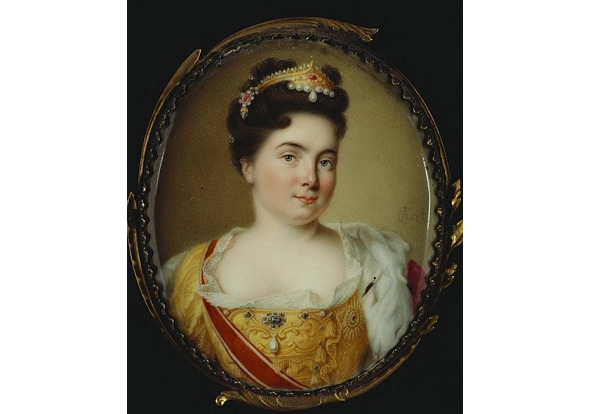
Catherine the First. She is Marta Samuilovna Skavronskaya, after the adoption of Orthodoxy – Ekaterina Alekseevna Mikhailova (1684 – 1727). For female wisdom (one might say – not for a model appearance), she is acclaimed by Field Marshal Sheremetev, and then by Alexei Menshikov. In 1703, during a visit to a friend, Peter the Great notices Martha and takes her to his place.
Peter begins to think about a successor. He and his brother Ivan the Fifth have no more sons. The new decree, allowing the monarch to appoint any person, including a woman, as heir to the throne himself, causes some ferment in society. In the same 1724, the tsar’s kidney stone disease was aggravated. Catherine is suspected of adultery. Her candidacy for a high post is being questioned.
In February 1725 Peter the Great dies.
For two years Catherine the First (Skavronskaya), the king’s widow, has ruled. She exhausts her strength at balls and feasts, and in 1727 she leaves the sublunary world.
The last representative of the Romanovs in a straight line, eleven-year-old Pyotr Alekseevich, the son of Tsarevich Alexei who died in prison, ascends the throne. Almost immediately A. Menshikov, the «semi-sovereign ruler,» betrothed him to his 16-year-old daughter Maria.
The new rulers, not lovers of hasty changes, are moving the capital back to Moscow. The military fleet is in decline. The boyars and the Supreme Privy Council rule, and not an heir, prone to wine since childhood. Locally and centrally, the nobles do whatever comes to their mind.
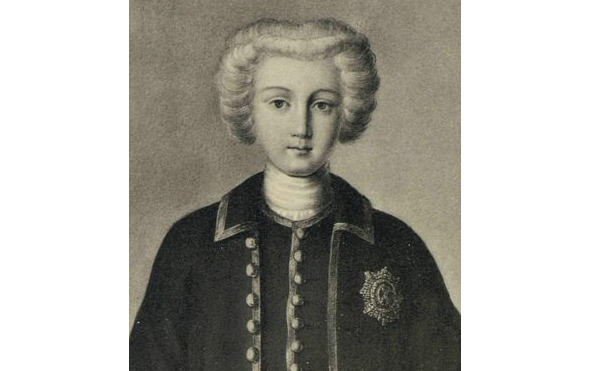
Peter II (1715 – 1730), son of Tsarevich Alexei Petrovich and German princess Sophia-Charlotte. He ascends to the throne at the age of eleven, studies hardly an hour a day, does not show interest in state affairs, kills thousands of rabbits while hunting, dies at fourteen.
In 1730, Peter II died of hypothermia and fever, which complicated the disease with smallpox. This actually ends the Romanov dynasty.
At the Privy Council, the Dolgoruky presents a forged testament to the emperor; to give the rights to the throne to the bride of Peter II, Ekaterina Dolgoruka. The powerful Golitsyns make their competitors laugh. Anna Ioannovna, daughter of Peter the Great’s brother, Ivan the Fifth, widow of the Duke of Courland, becomes Empress.
In 1735, another war starts with Turkey and the Crimean Khanate. The Russian army captures Azov and Ochakov. With an interval of a year or two, three trips to the Crimea are carried out. The army even reaches Bakhchisarai, the capital of the khanate, but returns due to lack of food and water. The cholera epidemic that broke out in 1736 reduces a significant part of the army, as well as the entire population of the peninsula. The European allies are withdrawing from the war. According to the Belgrade Peace Treaty of 1737, Russia loses all conquests, except for Azov, subject to the tearing down of its fortifications. Exit to the Black Sea and trade are allowed exclusively on Turkish ships.
Laughing at the Dolgoruky, trying to make the monarchy manageable, the Golitsyn brothers fall into disgrace on charges of high treason.
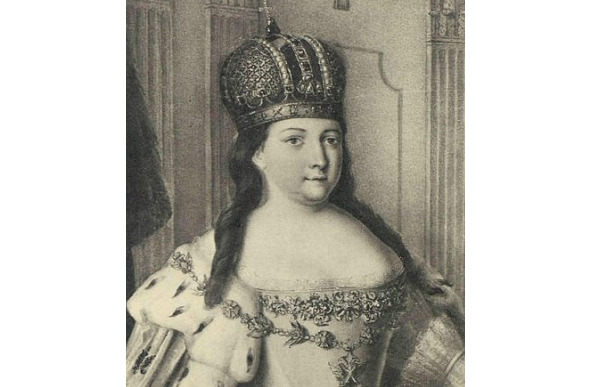
Anna Ioannovna (1693 – 1740), Russian empress, fourth daughter of Ivan the Fifth and Tsarina Praskovya Fyodorovna.
In 1740 Anna Ioannovna dies from an attack of urolithiasis. According to the will, the son of the empress’s sister, two-month-old Ioann Antonovich, becomes the emperor. With the regency of the mother and the supervision of Biron, the baby rules the year. Further, to the throne, with the help of the Guards of the Preobrazhensky regiment, who do not want to fight in cold Finland against the Swedes, Elizaveta Petrovna, the daughter of Peter the Great, who was born before the tsar married Catherine Skavronskaya, rises to the throne. All portraits, church books, passports, coins with the image of the juvenile king are confiscated. Ivan the Sixth together with his parents goes to the Shlisselburg Fortress. Here he, playing with spiders and rats, is kept in solitary confinement, out of communication with people.
In 1741, Sweden, not yet realizing that it had entered the category of militarily second-rate European powers, wishing to return the Northern Territories, declared war on Russia. The main actions take place all in the same Finland. A year after her accession to the throne, Elizabeth inclines the people of these lands to the side of Russia. The main carrot is the possibility of creating your own state. The forces of the parties are approximately equal. The losses are also about the same. The Russian army 10,500 people, the Swedish – 12,000. In the end, the Swedish army capitulates, goes home, leaving the Russian artillery.
In 1757, as part of a broad coalition, Russia launched military operations against Prussia. The reason is the illegal annexation of Saxony. Together with the Austrian troops, during the Battle of Kunersdorf, she manages to defeat the army of Frederick II. Of the 48 thousand soldiers, according to the German monarch himself, only 3 thousand remain alive. But the allies get entangled in orders and, instead of an immediate march on Berlin, disperse. Presumably, this «miracle» is associated with Catherine-Friderica, the future empress and her entourage – the commander-in-chief Apraksin and Chancellor Bestuzhev, who are playing their secret game at the court of Elizabeth. The second «miracle of the Brandenburg House», which Adolf Hitler hoped for a third time later, will take place in January 1762. Peter III, who ascended the throne, an ethnic German, a fanatical admirer of Frederick II, will break the treaty with Austria without explanation and conclude a separate peace.
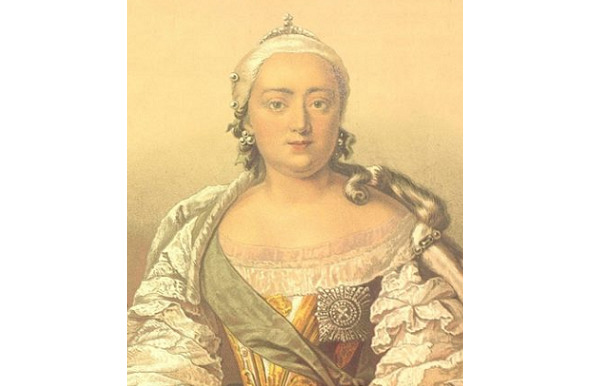
Elizaveta Petrovna (1709 – 1761), the youngest daughter of Peter the Great and Catherine. The Empress gives rise to Gallomania. Since childhood, dreaming of becoming related to the Bourbons, she diligently studies French. Elizabeth is in a secret church marriage with Alexei Razumovsky. For a child born in this marriage, Princess Tarakanova (self-name – Elizaveta Vladimirskaya) posed herself or appeared to be one.
In 1761, the childless and unmarried Elizabeth dies of an undiagnosed illness after a sudden throat bleeding. She is inherited by the grandson of Peter the Great, the son of his daughter Anna from his second marriage and the Duke of Holstein, the Holstein-Gottorp (German) ducal dynasty. Actually, according to the dynastic rules of inheritance, Anna joins this clan. Her children can no longer be «Romanovs» at all. But, in the conditions of a political crisis, this trifle is not paid attention. The main thing now is at least a bit of «royal» blood.
So, Karl Peter Ulrich, aka Peter the Third Fedorovich, occupies the Russian throne. The health and upbringing of the boy is affected by the fact that at one time the prince was flogged with rods, put his knees on peas, and subjected to more sophisticated tortures. The young man seems to be inclined to military affairs. However, he attaches importance not to the maneuvers and material support of the army, but to drill and parades. At the age of 17, already at the Russian court, Peter was married to Sophia Frederick Augusta, a native of the German city of Stettin, the future Catherine II. The dignitaries even assign mentors to the couple of monarchs – an exemplary married couple. But, it doesn’t help much. Instead of fulfilling the duties assigned to her husband, according to contemporaries, in the evenings the prince plays with the tin soldiers. Peter is unpleasantly surprised when, in 1754, Catherine still gives birth to his son Paul (the future emperor). However, the emotional attachment between the spouses remains.
Under Peter III, some sensible laws begin to work, but these are, rather, the homework of influential nobles. The monarch’s own initiative is the return of East Prussia, which has been part of the Russian Empire for four years, to its former owner, beloved Emperor Frederick II. Not quite fulfilled idea – reduction of church property, abolition of monastic land tenure, ban on icons. The third remarkable idea of the native of Holstein is a dynastic war with Denmark, a long-time ally of Russia, for the Schleswig (territory in the south of Denmark) taken from the German ancestors of Peter III.
Peter is also thinking about marrying his favorite, Elizaveta Vorontsova. Relations with his legal wife, Catherine, naturally deteriorate somewhat. In particular, the emperor considers it possible to call her a «fool» in the presence of the court and foreign princes, for refusing to listen to the toast while standing.
Interested persons are preparing a palace coup. These things usually require high-quality cash. Catherine turns to the French and British for help. The French try not to understand subtle hints. But the British ambassador easily gives the requested amount: 100 thousand gold rubles.
Peter the Third hesitates to march to Denmark, wishing to properly celebrate his name day (June 28, 1762) in Peterhof. However, upon arriving at the palace, he does not find the official organizer of the holiday – his other half, Catherine. She is already in St.Petersburg, taking the oath of office from St. Synod, Senate, guards regiments and part of the population. Again hesitating disastrously, the monarch rushes on a yacht to Kronstadt. However, the garrison of the island-fortress has already managed to swear allegiance to Mrs. Catherine. The last way to save the throne and yourself is the army in East Prussia. But the emperor gets tired of such throwing. Peter returns to the residence and signs the decree of abdication.
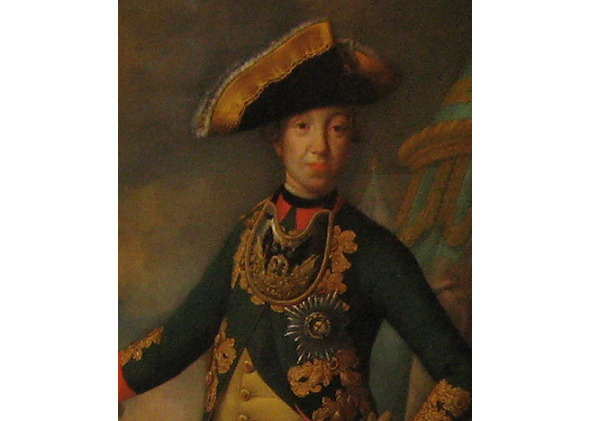
Peter the Third Fedorovich (1728 – 1762), Duke of Holstein, Russian emperor. The monarch’s father is Karl Friedrich Holstein, nephew of the Swedish king. Mother – Anna Petrovna, the second daughter of Peter the Great and Catherine the First.
The only desire now is for the wife to allow her husband to leave for his native Holstein. This is theoretically possible. Hardly ever. The situation requires complete certainty.
Peter the Third is kept in the palace of the town of Ropsha (near St. Petersburg), under the supervision of the eminent Orlov brothers. The officers do not dare to finish off the emperor with their own hands. They find a way out. Senator Grigory Teplov and Fyodor Volkov are involved in the operation, an actor, founder of the Russian Theater, once not recognized by Peter III as a stage genius. The latter, as follows from the research of historians, is the most likely murderer of the emperor.
Catherine II ascends to the Russian throne. The Catherine Age, the Golden Age of the nobility opens. Yes, the German Empress, a representative of the Gottorp sovereign house of the Oldenburg dynasty, who took the throne through a palace coup. But, it is the very precariousness of the situation that compels Catherine to respect the interests of the parties, to find balance, to carefully study the processes taking place in society. She is not a regent under her son Paul, but, contrary to the rules, «at the will of all Our loyal subjects, explicit and unfeigned», a full-fledged empress.
One of the innovations is the secularization of monastic lands. Previously, the collection of taxes, the management of the villages belonging to the church was carried out by the clergy themselves. Farmers worked out corvée, performed a lot of natural obligations introduced «out of friendship», and fell into debt bondage. Now the peasants, numbering a million, and this is only males, are being freed from church feudal lords. They acquire many liberties, legal rights, are called «economic» and pay one and a half rubles a year to the state personally. Their villages are under the supervision of retired officers. Monasteries, the number of which is reduced by three times, are paid amounts for their maintenance from the state treasury.
The influence of Russia in Poland is growing. Polish and Lithuanian magnates openly oppose the monarch Stanislav Poniatowski, who was elected in 1764. The side of the ex-lover of Catherine II is taken by a powerful eastern neighbor. At the invitation of the king, the empire introduces a military contingent into the territory of the Commonwealth. Suffering defeat after defeat from the troops of Suvorov, the Confederates find nothing better than to turn to Turkey (the reward for the help of the Ottomans is Volhynia and Podolia).
…In May 1764, the Empress, after consulting with the scientist M. Lomonosov, dispatches an expedition to the North Pole. The commander of six ships equipped with perfect equipment of that time was Captain V. Chichagov. The expedition stops northwest of Spitsbergen (Grumant Island), reaching a latitude of 80 degrees and five minutes, in front of insurmountable ice. The second campaign wins over the North by only one geographic minute. Thus, Lomonosov’s hope that «the ice will disperse» and the Russian ships will reach the shores of North America is not justified.
…Using some pretext, the Turkish authorities imprison the Russian ambassador Obreskov in the Seven-Tower Castle. This, according to Ottoman custom, means the beginning of a full-scale war. In response, on November 29, 1768, Catherine also declared war. The Russian fleet is sent to the Mediterranean Sea under the control of the favorites, the Orlov brothers. Its main goal is to incite anti-Turkish uprisings among the Christian peoples conquered by the Ottomans. Crimean Tatars cross the Russian border and attack Novorossiya. The wheel of war is turning. The Russian detachment occupies Azov and Taganrog. The clatter of axes and the grinding of saws marks the revival of the Azov flotilla. On the other side of the theater of military operations, Prince Golitsyn provokes the Turks, departs, and waits for two months for the booty to come to him by itself. Indeed, the Turks come, but because of the corruption that reigns now in Ottoman society, they are worn out, hungry and demoralized. In 1770 a series of fierce battles will take place. We should especially note the battle near the Cahul River, in the south of modern Moldova. The forces of the sides: the Russian army – 32 thousand, 118 guns, the Turkish army – 150 thousand with 140 guns. A detachment of Tatars, 80 thousand soldiers is preparing to attack Rumyantsev’s carts. The commander withdraws part of the troops to protect them. Only 17 thousand people remain for the general battle. On the night of August 1, soldiers line up in squares of 800 soldiers and move at an accelerated pace towards the Ottoman army. It is difficult for the Turkish cavalry, like cavalry in general, to attack the cadre infantry prepared for battle. Russian guns are effective. Confusion is caused by ten thousand janissaries who have appeared on the flank. After the intervention of officers, the square continues the offensive. A detachment of Kurds as part of the Ottoman army, instead of helping the Turks, is taken to plunder them. The next day, a Russian detachment attacks the Danube crossing. Here, on 300 ships, the remnants of the Turkish army are trying to evacuate. Losses of the parties. The Turkish army has 8 thousand soldiers, 140 cannons, 4 thousand prisoners «on a moderate basis». Russian army – 364 people.
Further, almost without resistance, Russian troops for the first time capture the strategically important fortress of Izmail. Problems with the delivery of provisions, the establishment of comprehensive relations with allies are a thing of the past. Catherine’s army remains to spend the winter in Moldavia and Wallachia.
The Russian fleet moves from the Baltic to the Mediterranean, losing 40% of the materiel due to leaks and other incidents. For the occupation of Turkish fortified points, together with the Greek rebels, amphibious assault forces are landed. At first, things are successful, but after the Greeks brutally dealt with the prisoners of war – no longer. In addition, there are two admirals at the head of the fleet, which cannot but cause some friction. Favorite of Catherine II, Alexei Orlov acts as a powerful arbiter. After a warm-up clash in the Chios Strait, where the losses of the parties are approximately equal, the Battle of Chesme takes place. It develops simply. After a serious artillery barrage, the Russian ships release four fire-ships against the Turkish fleet huddled in the bay. With two such oared torpedoes, the crew is evacuated in boats too early. The third ship runs aground near the coastal battery, preventing it from conducting aimed fire. The fourth «torpedo» interlocks with the battleship, ignites it and, a few minutes after the team leaves the fire-ship, explodes.
Debris falls on other Turkish ships, causing a firestorm. 14 Turkish battleships, 6 frigates and an uncountable number of small ships are burning, sinking. Out of 15 thousand Turkish sailors, 4 thousand are saved. The Russian fleet controls the entire Aegean Sea. The blockade of the Dardanelles begins – a number of straits between the islands off the western coast of Turkey. The main goal, in the future, is the capture of Constantinople. Russian citizenship is accepted by 27 islands of the Aegean Archipelago. The fleet numbers up to 50 pennants. In August 1773, a Russian squadron begins the siege of Beirut (then Syrian). Two months later, the city capitulates. It is passed on to the allies who have accepted the patronage of Russia. At the same time, 200,000 piastres of indemnity, according to the Naval Regulations (not the usual correct war for the Russians), are distributed among the ship’s crews.
In July 1774, the parties to the conflict signed the Kuchuk-Kainardzhiyskiy (place in modern Bulgaria) peace treaty. In comparison with the successes of the Russian army and the funds spent, he is modest. Russia acquires Kerch and a part of the northern coast of Crimea, with the right of navigation in the Black and Mediterranean Seas (unhindered passage through the Straits), also 4.5 million rubles in indemnity. The Crimean Khanate becomes independent from Turkey. A number of territories, including Ochakov, remain in the possession of the Port. The population of the Dardanelles who have taken Russian citizenship has to be transported by ships to Kerch and St. Petersburg. In 1778, Alexander Suvorov organized the resettlement of 30 thousand Christians persecuted from the Crimea to the Azov region.
The funds allocated for the military expedition are truly enormous. Catherine II, for the first time in the history of the Russian state, turns to foreign loans. The external debt, which exceeds the annual budget at times, is swelling. Inflating territories, which is not a bad thing in itself, and increasing international prestige, does not improve the life of the population of Central Russia. The cost of bread increases 4—6 times. Farmers often starve and slowly but surely turn into slaves.
In 1769, the first Russian paper money came into circulation. This is an obligation-receipt for receiving a coin (if copper nickels, 20 kilograms for 20 rubles). Very popular banknotes are in circulation until 1843. A cow and a horse cost a ruble and a half, the same tithe of land (a little more than a hectare). Sermyaga (simple clothes) – 20—40 kopecks, an ax 7 kopecks, a pood of rye – 5 kopecks. The most popular among the people are dimes. Gold coins are used for international payments. A foreman at a state plant receives 120 rubles a year (33 kopecks a day), while a freelance worker gets 20 rubles.
Under Catherine II, the market for people was finally formed. At the prices of 1782, the standard inventory of the estate: «… In the courtyard of courtyard people: Leonty Nikitin is 40 years old, according to an estimate of 30 rubles. His wife Marina Stepanova is 25 years old, estimated at 10 rubles. Efim Osipov 23 years old, according to the estimate of 40 rubles. His wife Marina Dementieva is 30 years old, estimated at 8 rubles. They have children – a son Guryan 4 years old, 5 rubles, the daughter of a girl Vasilisa 9 years old, according to the estimate of 3 r., Matryona is one year old, according to an estimate of 50 k. «A good village «girl» can be bought by a landowner for 200 rubles. Pedigree puppies are more expensive – up to 10,000 rubles.




